GSTR-9C refers to an annual GST reconciliation statement that has undergone significant changes in the year 2021. The form GSTR-9C was previously applicable to businesses generating more than two crore rupees of yearly turnover in the given FY. Filing of GSTR-9C seeks the audit of books and records of the given FY certified by the practising CA or certified management accountant. Now such requirements have been obliterated from the FY 2020-21 onwards. Under new changes, businesses are required to self-certified the Form GSTR-9C. This write-up renders a detailed snapshot of the Amendment of the underlying norms of the CGST Act, the format & the corresponding provisions regulating Form GSTR-9C.
Format & the applicability of GSTR-9C prior to the Amendment
- Businesses functioning under the GST regime generating over Rs.2 crore as annual aggregate turnover in FY had to audit their book of accounts enclosing the annual financial statements u/s 35(5) of the CGST Act.
- After concluding the GST audit, the auditor had to pinpoint any loopholes with the management, outline a reconciliation statement between the audited statements & form GSTR-9 filed for the particular financial year.
- The form was also regarded as GSTR-9C facilitated by Section 44 of the CGST Act, read with CGST Rule 80, & this form seeks the approval of the same auditor or the eligible CA/CMA. It had to be outlined for every registered GSTIN under a specific PAN.
- Upon completing the certification, the business has to file both Form GSTR-9C & Form GSTR-9 on the GST portal[1] on or before the 31st December of the year following the financial year.
- The taxpayer was allowed to pay any additional liability cited in this form via Form DRC-03. They must opt for ‘Reconciliation Statement’ from listed under the drop-down in Form DRC-03 & cater to such liability only via the electronic cash ledger.
- The GST department takes the detail shared in Form GSTR-9C into account to determine potential loopholes in the taxpayer’s compliances & reporting. In case of any error, the department issues notice to the taxpayer.
- The format of the preceding form GSTR-9C had the two imperative parts, i.e. Part A and Part B. Part A enclosed the reconciliation statement along with any differences. Meanwhile, Part B enlisted the certification by the auditor.
Part-A was further bifurcated into five important parts as shown below:
| Part No. | Particulars |
| Part-I | Basic information such as Trade name, GSTIN, & any requirement of audit mentioned under any other law. |
| Part-II | Reconciliation between the annual turnover derived from auditor’s certified annual financial statement for a specific GSTIN 7 the turnover cited in the Form GSTGR-9 |
| Part-III | Reconciliation & differences, if any, between the GST based taxed obligations & payment as cited in Form GSTR-9 & derived from the audited financial statements for a specific GSTIN. |
| Part-IV | Reconciliation & differences, if any, between the ITC availed & utilized as cited in Form GSTR-9 & derived from the auditor’s certified financial statements for a particular GSTIN. |
| Part-V | Auditors’ feedback on any additional unreconciled liabilities. |
Part-B served the two purposes. The auditor could utilize the first format for certifying the GSTR-9C form himself. The second format could be utilized by a Charted Accountant/CMA who was not directly involved in the auditing but certifies the GSTR-9C based on the auditor’s observations.
Changes inculcated by the Union Budget 2021 & notifications
The Union Budget 2021 announced two vital changes in Section 35 & 44 of the CGST Act. The GOI has got rid of Section 35(5) of the CGST Act. Moreover, Section 44 of the CGST Act stands amended. The Amendment in the Act was sanctioned with the passing of the Finance Act, 2021.
Following are changes made to the CGST Act
- The need for a GST audit by charted accountant stands ineffective for FY 2020-21 & any subsequent years. Every registered person must file a self-certified reconciliation statement by reconciling values between the annual returns & the auditor’s certified financial statements.
- Some registered person may be exempted from the complying with the reconciliation statement & the annual return via the CBIC notification.
- Section 44 shall not apply to any state or central government departments already liable to audit by the CAG (Comptroller and Auditor-General of India).
- The GST council reconfirmed these amendments at the 43rd GST council meeting took place on 28/May/2021. The CBIC notified such changes on 30/7/2021 via Central Tax notifications 29/2021 &30/2021. It provided with the imposition of Sections 110 & 111 of the Finance Act, 2021 that enclosed these changes. Furthermore, Part-B of the CGST Rules & Rule 80(3) has undergone changes to specify the threshold limit imposition & inculcate changes to the format.
- In view of this, Form GSTR-9C applies to a registered person if the annual overall turnover limit for the given FY is more than Rs 5 crore. The form GSTR-9C’s format has been altered to enclose FY 2020-21 & to support certification.
Applicability of Form GSTR-9C from Financial Year 2020-21 onwards
- Form GSTR-9C shall remain exempted for ISDs, taxpayers fall under TDS and TCS provisions, casual taxpayers with the overall annual turnover lower than or equivalent to Rs 5 crores are appended to the exemption category.
- Accordingly, Form GSTR-9C shall apply to taxpayers with an overall turnover for the given FY being more than Rs 5 crore. These individuals are mandated to self certify or perform a voluntary reconcillation statement without the auditing requirement & file it with the tax department on or before Dec 31 of the FY following the relevant FY.
The following table manifests the threshold applicability of both the reconciliation statement & the annual returns for FY 2020-21.
| Form Name | Applicability- AATO* threshold for Financial Year 2020-21 | The due date for Financial year 2020-21 |
| GSTR-9 | > Rs.2 crore | 31st Dec 2021 |
| GSTR-9C | > Rs.5 crore | |
*Annual aggregate turnover during the Financial Year 2020-21.
Summarised table of changes to Form GSTR-9C
(Changes applicable for Financial Year 2020-21 & onwards)
Changes made to the Part-A: Reconciliation statement is given below:
| Reference to part &/or table no. | Particulars | Changes made |
| Part-II – Tables 5B to 5N | Reconciliation of the yearly turnover as per the auditor’s certified annual financial statement with the turnover cited in Form GSTR-9 | These tables are optional while filing form GSTR-9C for financial year 2020-21. Table 5O can be used for any adjustments. |
| Part-III and Table no. 9 | Reconciliation of GST rate-wise tax obligation & the amount payable | A new row is added below K- 0.10% to now have ‘K-1’ for other rates of GST not listed above it. |
| Part-III and Table no. 11 | Any additional sum that yet to be paid (owing to the reasons cited under Tables 6,8 and 10) | A new row ‘others’ is added below 0.10% to now have other rates of GST not cited above it. |
| Part-IV- Tables 12B, 12C, and 14 | Reconciliation of ITC i.e. Input Tax Credit | These tables are optional while filing form GSTR-9C for Financial Year 2020-21. |
|
Part-V | Auditor’s feedback on any additional obligations owing to non-reconciliation | Heading altered to “Additional Liability owing to non-reconciliation”A new row ‘others’ is added below 0.10% to now have other GST rates not cited above it. |
| Verification |
Verification of the taxpayers | Superseded by the following lines: I hereby solemnly assure & declare that the detail given mentioned above is legit & correct, & nothing has been hidden therefrom. I am submitting the self-certified reconciliation statement in GSTR-9C form. As applicable, I am also submitting other statements, including P & L account, Financial Statements, & balance sheet, etc. |
| Instruction -serial no. 7 | Part V – Additional obligation owing to non-reconciliation | The instruction’s wording are changed to discard references to the auditor & their feedbacks as follows: Part-V entails of the additional liability to be catered by the registered person owing to non-reconciliation of the ITC or non-reconciliation turnover. The taxpayer must also share any refund that has been accidentally paid back to the tax authority. Any other outstanding demand to be reconciled by the registered taxpayers also goes in this table. |
Conclusion
GSTR-9C refers to annual GST reconciliation statement that encountered several changes in 2021. The form GSTR-9C was previously applicable to business entities having more than Rs 2 crore as annual turnover in the given FY.
Read our article:GSTR-2A and GSTR-2B: Know the key differences











